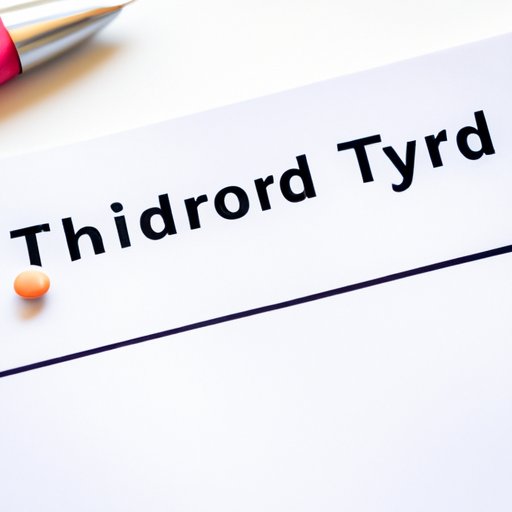
Introduction
Free thyroxine is a critical hormone that plays a vital role in various body functions, such as metabolism, energy level, and hormonal balance. Understanding the role and importance of free thyroxine is crucial for maintaining overall health and detecting thyroid gland disorders. In this article, we will explore the significance of free thyroxine, its functions, and the tests and techniques used to detect imbalanced levels.
Explaining the Importance of Free Thyroxine for Thyroid Health
The thyroid gland is a small butterfly-shaped gland located in the front of the neck that produces thyroid hormones. Free thyroxine, also known as free T4, is one of the two primary thyroid hormones produced by the thyroid gland that has a significant impact on the overall health of the body.
Free thyroxine is termed “free” because it is unbound to a protein carrier. It is the active form of the hormone that affects how the body breaks down energy and uses it. Thyroxine is converted into triiodothyronine (T3) in the body; this conversion process is necessary for multiple processes in the body, including growth and development, metabolism, and body temperature. When thyroxine and triiodothyronine levels are low, it signals the hypothalamus to release thyrotropin-releasing hormone (TRH), which causes the pituitary gland to release thyroid-stimulating hormone (TSH). This process triggers the thyroid gland to produce more thyroxine.
Irregular levels of free thyroxine in the blood can impact the optimal function of the body, leading to numerous negative impacts from weight gain or loss and fatigue to mood changes and reduced cognitive function.
Understanding the Role of Free Thyroxine in Hormonal Balance
Free thyroxine plays a vital role in the body’s hormonal balance. It controls the metabolic rate, which is the process by which our body breaks down molecules and converts them into energy. Along with other hormones in the body, free thyroxine ensures that the body’s metabolism runs smoothly.
An imbalance in free thyroxine levels can cause hormonal imbalances and produce symptoms such as irregular menstrual cycles, decreased libido, and difficulty losing weight. Thyroid hormones also impact the body’s stress and reproductive hormones, making it essential to maintain healthy levels of free thyroxine.
How Free Thyroxine Affects Metabolism and Energy Levels
Free thyroxine significantly impacts the metabolic rate, which affects how the body uses available energy. The hormone directly influences the basal metabolic rate (BMR), which represents the amount of energy used while the body is at rest. Frequent BMR fluctuations can lead to imbalanced weight.
Low free thyroxine levels can slow down the metabolism, leading to weight gain, fatigue, and lethargy. On the other hand, elevated free thyroxine levels can result in hyperthyroidism, increasing metabolism and leading to weight loss, mood swings, and anxiety.

The Difference Between Free Thyroxine and Total Thyroxine
Total thyroxine measures the total amount of thyroxine bound to proteins while free thyroxine measures unbound thyroid hormone, which is the active form that affects the body. While total thyroxine levels can vary due to changes in protein binding or other factors, free thyroxine is a more accurate measurement of thyroid function.
Diagnosis of thyroid disorders solely based on total thyroxine levels can be difficult as it does not provide an accurate representation of thyroid status. Without testing free thyroxine, thyroid function can remain undiagnosed and untreated. Test results showing low free thyroxine levels indicate hypothyroidism, and high showcases hyperthyroidism.
Common Tests and Techniques for Measuring Free Thyroxine Levels
Testing free thyroxine levels is vital for monitoring thyroid function and diagnosing any related disorders. The most common tests to check free thyroxine levels include:
- Radioimmunoassay: This method involves using tagged antibodies that bind themselves to free thyroxine. The amount of radiation measured helps determine the quantity of the thyroid hormone in the body.
- Enzyme-linked Immunosorbent Assay (ELISA): ELISA is a technique that uses specific antibodies to identify and measure free thyroxine levels.
- Chemiluminescent Immunoassay (CLIA): CLIA is an automated test that uses specific antibodies to quantify free thyroxine levels.
Doctors may advise thyroid function tests to patients with unexplained weight changes, fatigue, depression, or changes in heart rate. The normal range for free thyroxine is generally between 0.8 and 1.8 ng/dL. Non-normal levels indicate an underlying disorder of the thyroid gland.
The Effects of Imbalanced Free Thyroxine Levels on Overall Health
The thyroid gland plays a crucial role in regulating the body’s overall functioning. Imbalanced free thyroxine levels can negatively impact many body systems, causing symptoms such as:
- Weight gain/weight loss
- Depression and anxiety
- Changes in heart rate and blood pressure
- Hair loss and brittle nails/li>
- Menstrual irregularities and fertility disorders
- Elevated cholesterol levels
- Decreased libido and muscle weakness
- Fatigue and cold intolerance
- Dry skin and puffiness around the eyes
- Joint pains and swelling
Therefore, it is crucial to monitor free thyroxine levels regularly to ensure optimal thyroid function and prevent the negative impacts of imbalances.
Conclusion
To maintain overall health, it is essential to understand the significance and role of free thyroxine in the body. Getting regular thyroid function tests and monitoring thyroxine levels is necessary for early detection of any underlying thyroid gland disorders. Remember to seek medical attention and discuss any concerns with your healthcare provider, as they will guide you on the best way to maintain healthy free thyroxine levels.




